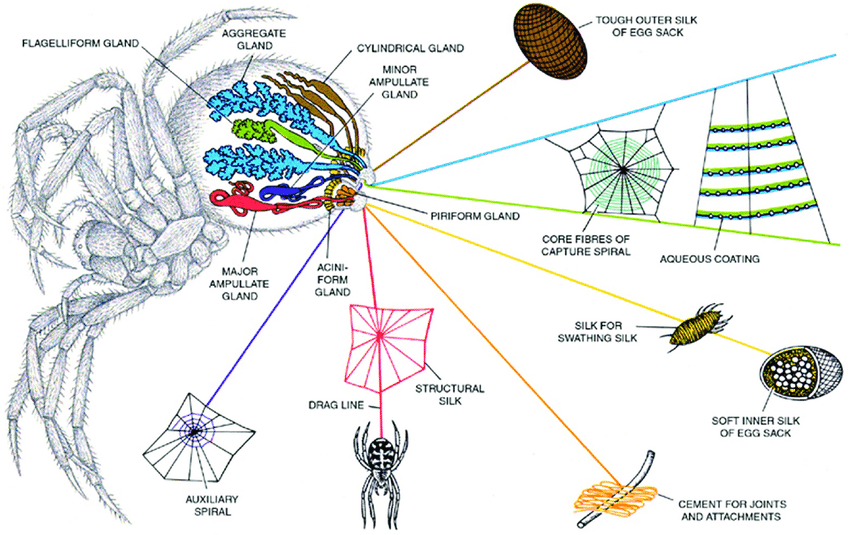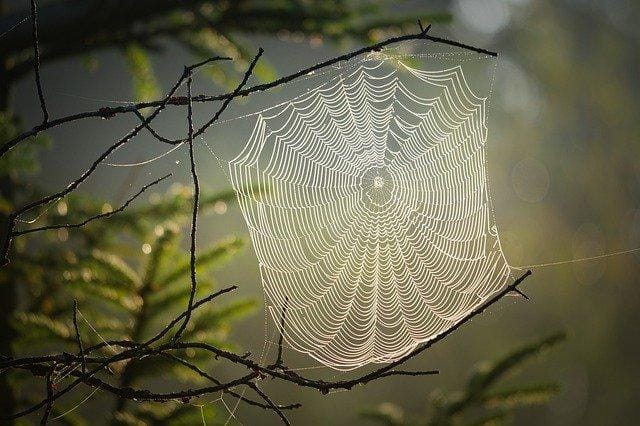Fun fact: Spider silk is so light that a single strand long enough to circle the Earth would weigh less than a bar of chocolate!
If You are curious and looking for a question that how does a spider make a web, you have landed on a right place. Spiders are extraordinary arthropods known for their ability to create intricate webs. These structures, vital for their survival, are a marvel of biological engineering. Spiders are nature’s engineers, and their web construction serves multiple purposes—from catching prey to offering shelter. But how do these tiny creatures create such complex structures? By delving into the mechanics of web-building, we uncover the sophisticated processes and materials that underline their construction. This article provides a detailed scientific perspective on how a spider makes a web and the fascinating biology behind it.
Table of Contents
- What Is a Spider Web?
- What Is Spider Silk Made Of?
- Silk-Producing Glands: A Biochemical Overview
- How Does a Spider Make a Web: Step-By-Step Guide
- Spider Silk: Properties and Functions
- How Spiders Construct Webs Across Wide Gaps Between Structures?
- Types of Webs and Their Functions
- Can All Spiders Make Webs?
- How Long Does It Take a Spider to Make a Web?
- The Role of Webs in the Ecosystem
- Conclusion
What Is a Spider Web?
A spider web is an architectural marvel made of silk—a protein-based fiber produced by specialized silk glands in a spider’s body. These webs are multifunctional, they use their webs primarily to catch prey, but webs can also act as shelters, mating grounds, and even protection for their eggs. The silk is not just any ordinary thread—it’s an incredibly strong, stretchy material that’s often compared to steel in strength. Understanding how a spider makes a web begins with examining this incredible material.
What Is Spider Silk Made Of?
Spider silk is composed of proteins, primarily fibroin. This protein gives silk its durability and elasticity. Spiders produce silk in specialized organs called spinnerets, located at the rear of their abdomen. Different types of silk are created for different purposes—some for building webs, others for wrapping prey or making egg sacs.
Silk-Producing Glands: A Biochemical Overview

- Major Ampullate Glands: These glands secrete dragline silk, a highly durable fiber used to form the web’s framework and safety lines.
- Flagelliform Glands: Responsible for producing the elastic silk that makes up the capture spiral.
- Tubuliform Glands: These create the robust silk used in egg sac construction.
- Aciniform Glands: Produce silk used for wrapping and immobilizing prey.
- Piriform Glands: Secrete attachment disc silk, which anchors threads securely to surfaces.
- Aggregate Glands: These glands produce the glue-like silk droplets that are added to the capture spiral, enhancing its stickiness and effectiveness in trapping prey.
- Cylindrical Glands: Found in female spiders, these glands specialize in creating silk for egg sacs, providing a protective environment for developing spiderlings.
The combination of these silk types enables spiders to construct webs that are both functionally effective and structurally robust. This complex silk production is central to understanding how a spider makes a web that serves multiple purposes.
How Does a Spider Make a Web: Step-By-Step Guide
1. Site Selection: Optimizing Prey Capture
Spiders carefully select locations with high insect activity and minimal environmental disturbances. Preferred sites often have:
- Adequate structural supports such as branches or walls.
- Low exposure to wind or rain.
The choice of site is crucial in determining how effective a web will be in capturing prey, a fundamental part of how a spider makes a web.
2. Anchor Thread Formation
Web construction begins with the formation of anchor threads. The spider releases a strand of silk into the air, allowing it to attach to a surface via wind currents. This initial thread is reinforced multiple times to establish a strong foundation.
3. Framework Development
Using the anchor threads, the spider builds the web’s frame. This framework consists of polygonal shapes formed by stretching silk between key anchor points. The frame ensures the web’s structural integrity and highlights the precision involved in how a spider makes a web.
4. Radial Thread Installation
Radial threads extend outward from the center of the web to its edges, resembling spokes in a wheel. These threads provide both structural support and a navigational guide for the spider.
5. Spiral Construction
Temporary Spiral
The spider first spins a non-sticky spiral, which serves as a guide for spacing the capture spiral.
Sticky Spiral
Using silk from its flagelliform glands, the spider replaces the temporary spiral with a sticky one. Adhesive droplets are added to this spiral, enhancing its ability to trap prey. This meticulous spiral weaving is a defining step in how a spider makes a web.
Spider Silk: Properties and Functions
Mechanical Strength and Elasticity
Spider silk exhibits tensile strength comparable to steel and remarkable elasticity, enabling it to absorb the impact of prey without breaking.
Adhesive Qualities
The sticky silk of the capture spiral is specifically adapted to ensnare insects, providing a secure hold until the spider can subdue its prey. Spider silk can reflect UV light, making it almost invisible to insects.
Recycling Efficiency
Spiders optimize silk usage by consuming and recycling old web material, conserving energy and ensuring a steady supply of silk proteins. In short, spiders often eat their old webs to reuse the silk proteins. This resourcefulness is another intriguing aspect of how a spider makes a web.
How Spiders Construct Webs Across Wide Gaps Between Structures?

Spiders possess an extraordinary ability to build intricate webs that stretch between objects far beyond their own body size, sometimes many times their length. It’s a demonstration of highly evolved behavioral engineering, unique silk-producing capabilities, and a keen sensitivity to environmental dynamics. To bridge these wide spans, spiders deploy a specialized type of silk, known for its strength and elasticity by releasing it into the air and letting wind currents carry the initial thread to a distant anchor point. Once the thread makes contact with a stable surface, the spider carefully tests its tension, reinforces it, and begins weaving the structural foundation of the web. This process showcases not only their silk’s adaptive properties but also the spider’s calculated approach to web placement and architecture.
Wind-Assisted Bridge Threading
One of the most fascinating strategies spiders use to connect their webs to faraway surfaces is known as wind-assisted bridging. This technique begins with the spider ascending to a high elevated position, often the edge of a branch, rock, or man-made structure. With its abdomen tilted upward, the spider releases an ultra-fine, sticky silk thread, allowing it to drift on ambient air currents. This lightweight bridge thread or gossamer silk is carried by even the slightest breeze, including minor air currents from ground warming.
A stunning example of this behavior can be seen in the Darwin’s bark spider (Caerostris darwini), a species native to Madagascar. This spider pushes the limits of what silk can achieve by deploying unusually long and voluminous bridge threads that travel across open bodies of water. These threads, carried downwind, can connect objects as far as 25 meters apart, earning the species the distinction of building the largest known orb webs in nature.
The success of this method hinges on the exceptional properties of spider silk. It’s not only incredibly light but also incredibly strong, stronger than steel by weight. Once the floating silk makes contact with a distant structure, it may adhere due to static electric charges. The spider then tests the attachment by pulling on the thread to verify its stability before proceeding with web construction.
Ballooning Behavior
Many spiders employ ballooning, a related but distinct behavior used primarily for dispersal rather than web construction. During ballooning, spiders release multiple silk threads that form a triangular parachute like structure, allowing them to become airborne and travel considerable distances. While primarily used for moving to new locations, this behavior demonstrates spiders’ sophisticated understanding of aerodynamics and their ability to manipulate air currents.
Recent research has revealed that spiders actively evaluate wind conditions using their front legs before attempting to balloon, waiting for optimal conditions rather than simply releasing silk randomly. They can detect suitable updrafts of just 0.1-0.5 m/s and prefer wind speeds below 3 m/s for successful ballooning.
Types of Webs and Their Functions
1. Orb Webs
Commonly constructed by orb-weaving spiders, these webs are symmetrical and circular. They are highly efficient for capturing flying insects.
2. Funnel Webs
Built by funnel-web spiders, these webs feature a tubular retreat where the spider resides. The web channels prey directly toward the spider.
3. Cobwebs
Cobweb spiders create irregular and tangled webs, typically found in sheltered areas such as building corners.
4. Sheet Webs
Sheet webs are horizontal, layered structures created by sheet-weaving spiders. A tangle of silk above the web enhances its prey-capturing efficiency.
Can All Spiders Make Webs?
Interestingly, not all spiders make webs! While most species do, others, like wolf spiders and jumping spiders, prefer to hunt actively rather than trap their prey. These spiders rely on speed and stealth instead of silk-based traps.
How Long Does It Take a Spider to Make a Web?
The time varies depending on the spider species and the complexity of the web. On average, spiders can construct a web in 30–60 minutes. Some intricate designs may take hours or even days to complete.
The Role of Webs in the Ecosystem
Spider webs play a crucial role in maintaining ecological balance. They help control insect populations, reducing the spread of pests and diseases. Spiders are unsung heroes in natural pest control, and their webs are a testament to their hard work.
The properties of spider silk have inspired numerous scientific advancements. Researchers are exploring its potential applications in creating biodegradable materials, medical sutures, and even bulletproof fabrics. Understanding how a spider makes a web at a molecular level could pave the way for innovative designs in engineering and materials science.
Conclusion
The scientific exploration of web construction showcases the evolutionary brilliance of spiders. Each stage, from silk production to structural design, reflects the intricate interplay between biology and function. Also reminds us of the beauty and complexity of the natural world. By understanding how a spider makes a web, we not only deepen our appreciation for these arachnids but also unlock potential breakthroughs in science and technology.

i appreciate the information
THANK YOU 🙂 KEEP READING
I was asking how spiders build webs attached to distant structures. Do they float on air currents to distant structures to attach their web string? Do they descend their current location and climb up the next? This article didn’t answer unfortunately but was an informative read.
Hi Suzann, thank you so much for finding the research article informative and for letting us know exactly what you were looking for. Our team has recently updated the article and added a new section titled “How Spiders Construct Webs Across Wide Gaps Between Structures.” We hope this answers your question. Keep reading, and feel free to reach out if you have any other questions, we’ll do our best to provide detailed information.